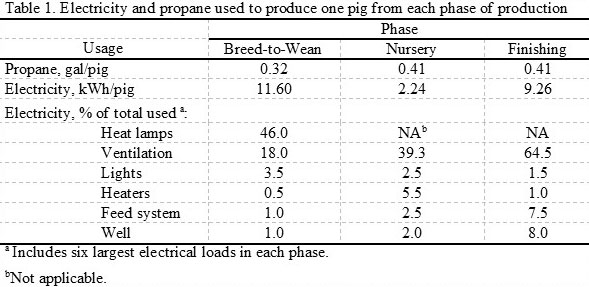By Kirsten Sharpe, Eric Buchanan, Mike Reese, Joel Tallaksen, Kevin Janni, and Lee Johnston
April 2018
Consumers are demanding products with a reduced environmental footprint and companies across the globe from Target to General Mills are advertising their commitment to environmental sustainability and minimization of ecological impacts. This commitment begins with working towards reducing carbon emissions and increasing sustainability at the foundation of these industries: the producers. Over the past several years, researchers from the West Central Research and Outreach Center (WCROC) have been working with pork producers to learn where fossil energy is used in pork production systems and to help them understand how to reduce their environmental footprint. A recently-completed project focused on electricity and heating fuel consumption in commercial swine barns to help shed some light on opportunities to reduce fossil energy consumption.
Typical Midwest pork production systems consist of three phases tailored to fit the needs of pigs at different life stages: breed-to-wean (sows and suckling pigs), nursery (weaned pigs to 50 pounds bodyweight), and finishing (50 pounds to market weight of about 280 pounds). During each of these phases, pigs have very different environmental requirements, which in turn require differing fossil fuel inputs. In the breed-to-wean phase, sows require extensive cooling during the summer, which is typically supplied by exhaust fans and hanging stir fans. The piglets in this phase require extensive heating especially during the first week of life which is supplied by propane heaters and heat lamps. In the nursery phase, pigs require both heating and cooling depending on their body weight and season of the year which are provided by propane heaters and fans, respectively. Pigs in the finishing phase typically require year-round cooling due to body heat generated by pigs in the barn.
To collect baseline energy data, two commercial facilities from west-central Minnesota representing typical Upper Midwest swine production systems were selected for each phase of production: two breed-to-wean barns (BW-A and BW-B), two nursery barns (NB-A and NB-B), and two finishing barns (FB-A, tunnel-ventilated and FB-B, curtain-sided). Electricity use was monitored by sensors installed on various loads throughout each barn (ex: ventilation fans, heat lamps, lights, etc.). Propane use was collected from propane invoices sent to the producers.

Electricity and propane use were averaged between barns within each stage of production and divided by the number of pigs produced from each barn (Table 1). Electricity and propane usage were similar between breed-to-wean barns despite a difference of 29,000 pigs produced annually from the two different barns. Heat lamps used the highest proportion of total electricity in both breed-to-wean barns. Electricity and propane usage per pig was similar in both nursery barns despite an annual pig production difference of 50,000 pigs. Ventilation accounted for the largest proportion of the total electricity used by each nursery. Total amounts of electricity used to produce one market pig ranged from 4.12 kWh (curtain-sided barn) to 14.40 kWh (tunnel-ventilated barn). Propane use ranged from 0.49 gal/pig (curtain-sided barn) to 0.34 gal/pig (tunnel-ventilated barn). Despite barn design differences, ventilation was the largest user of electricity during the finishing phase. Based on this study, heat lamps in breed-to-wean barns and ventilation systems across all three phases of pork production were the most significant users of electricity. We calculated the total use of fossil energy in these commercial barns by comparing the total fossil fuels used from electricity and propane. The energy used for heating the barns (propane) accounted for 50% (breed-to-wean barns) to 90% (nursery barns) of the total fossil energy used in the barn. The next largest user of fossil energy was heat lamps in farrowing rooms then the ventilation system across all three phases of production.
Our results suggest that pork producers need to focus on heating systems, ventilation systems, and equipment to keep piglets warm if they want to reduce the use of fossil fuels and improve the carbon footprint of their production system. In addition to improving the environmental impacts of their farms, improving the efficiency of these electrical loads and propane use should provide opportunities for increased profitability. For tips on improving energy efficiency of heating and ventilation systems in swine barns, visit presentations from our past Midwest Farm Energy Conference. Additionally, an article published on “The Pig Site” in 2012 outlines the importance of providing heat to pre-weaned piglets and advantages of utilizing heat pads versus heat lamps.
This project was funded by the Minnesota Environment and Natural Resources Trust Fund as recommended by the Legislative-Citizen Commission on Minnesota Resources (LCCMR).
